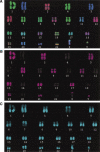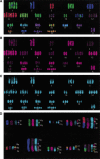Differentially painting human chromosome arms with combined binary ratio-labeling fluorescence in situ hybridization
- PMID: 10854417
- PMCID: PMC310904
- DOI: 10.1101/gr.10.6.861
Differentially painting human chromosome arms with combined binary ratio-labeling fluorescence in situ hybridization
Abstract
Recently we developed a novel strategy for differentially painting all 24 human chromosomes. It is termed COBRA-FISH, short for combined binary ratio labeling-fluorescence in situ hybridization. COBRA-FISH is distinct from the pure combinatorial approach in that only 4 instead of 5 fluorophores are needed to achieve color discrimination of 24 targets. Furthermore, multiplicity can be increased to 48 by introduction of a fifth fluorophore. Here we show that color identification by COBRA-FISH of all of the p and q arms of human chromosomes is feasible, and we apply the technique for detecting and elucidating intra- and interchromosomal rearrangements. Compared with 24-color whole chromosome painting FISH, PQ-COBRA-FISH considerably enhances the ability to determine the composition of rearranged chromosomes as demonstrated by the identification of pericentric inversions and isochromosomes as well as the elucidation of the arm identity of chromosomal material involved in complex translocations that occur in solid tumors.
Figures



Similar articles
-
Chromosome arm-specific multicolor FISH.Genes Chromosomes Cancer. 2001 Jan;30(1):105-9. doi: 10.1002/1098-2264(2000)9999:9999<::aid-gcc1068>3.0.co;2-9. Genes Chromosomes Cancer. 2001. PMID: 11107184
-
COBRA: combined binary ratio labeling of nucleic-acid probes for multi-color fluorescence in situ hybridization karyotyping.Nat Protoc. 2006;1(1):264-75. doi: 10.1038/nprot.2006.41. Nat Protoc. 2006. PMID: 17406243
-
[Analysis of complex chromosomal aberrations in patients with myelodysplastic syndromes using multiplex fluorescence in situ hybridization combined with whole chromosome painting].Zhonghua Yi Xue Yi Chuan Xue Za Zhi. 2007 Dec;24(6):635-9. Zhonghua Yi Xue Yi Chuan Xue Za Zhi. 2007. PMID: 18067073 Chinese.
-
COmbined Binary RAtio fluorescence in situ hybridiziation (COBRA-FISH): development and applications.Cytogenet Genome Res. 2006;114(3-4):222-6. doi: 10.1159/000094204. Cytogenet Genome Res. 2006. PMID: 16954657 Review.
-
Multicolor chromosome bar codes.Cytogenet Genome Res. 2006;114(3-4):245-9. doi: 10.1159/000094208. Cytogenet Genome Res. 2006. PMID: 16954661 Review.
Cited by
-
Functional CD8+ T cells infiltrate into nonsmall cell lung carcinoma.Cancer Immunol Immunother. 2007 May;56(5):587-600. doi: 10.1007/s00262-006-0214-y. Epub 2006 Aug 22. Cancer Immunol Immunother. 2007. PMID: 16924494 Free PMC article.
-
Selected In Situ Hybridization Methods: Principles and Application.Molecules. 2021 Jun 24;26(13):3874. doi: 10.3390/molecules26133874. Molecules. 2021. PMID: 34202914 Free PMC article. Review.
-
Long-range interphase chromosome organization in Drosophila: a study using color barcoded fluorescence in situ hybridization and structural clustering analysis.Mol Biol Cell. 2004 Dec;15(12):5678-92. doi: 10.1091/mbc.e04-04-0289. Epub 2004 Sep 15. Mol Biol Cell. 2004. PMID: 15371546 Free PMC article.
-
Intrinsic fluorescence from DNA can be enhanced by metallic particles.Biochem Biophys Res Commun. 2001 Sep 7;286(5):875-9. doi: 10.1006/bbrc.2001.5445. Biochem Biophys Res Commun. 2001. PMID: 11527380 Free PMC article.
-
Multicolor chromosome painting in diagnostic and research applications.Chromosome Res. 2004;12(1):15-23. doi: 10.1023/b:chro.0000009326.21752.88. Chromosome Res. 2004. PMID: 14984098 Review.
References
-
- Guan XY, Zhang H, Bittner M, Jiang Y, Meltzer P, Trent J. Chromosome arm painting probes. Nat. Genet. 1996;12:10–12. - PubMed
-
- Ledbetter D. The ‘colorizing’ of cytogenetics: Is it ready for prime time. Hum Mol Genet. 1992;1:297–299. - PubMed
-
- Nederlof PM, van der Flier S, Wiegant J, Raap AK, Tanke HJ, Ploem JS, van der Ploeg M. Multiple fluorescence in situ hybridization. Cytometry. 1990;11:126–131. - PubMed
-
- Ried T, Schrock E, Ning Y, Wienberg J. Chromosome painting: A useful art. Hum Mol Genet. 1998;7:1619–1626. - PubMed
Publication types
MeSH terms
LinkOut - more resources
Full Text Sources
Other Literature Sources
